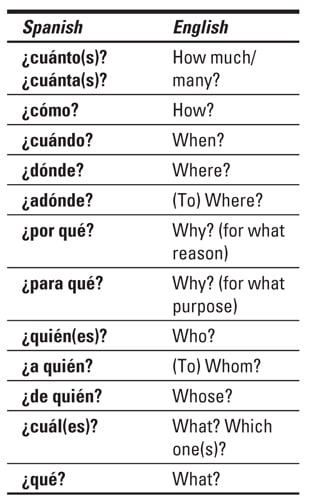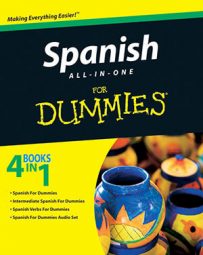How to form participles of regular Spanish verbs
Verbs are what breathe life and action into Spanish and every other language. Forming present and past participles in Spanish lets you talk in active present tense to say, “I’m dancing,” and about what you did last night: “I danced!” The following tables show you how to form present and past participles for regular Spanish verbs ending in –ar, –er, and –ir.
| Ending | Verb Example | Meaning | Participle | Meaning |
|---|---|---|---|---|
| -ar | bailar | to dance | bailando | dancing |
| -er | comer | to eat | comiendo | eating |
| -ir | subir | to go up | subiendo | going up |
| Ending | Verb Example | Meaning | Participle | Meaning |
|---|---|---|---|---|
| -ar | bailar | to dance | bailado | danced |
| -er | comer | to eat | comido | eaten |
| -ir | subir | to go up | subido | gone up |
How to conjugate regular Spanish verbs
As in almost every language, in Spanish you have to conjugate verbs because you use a different form of the verb depending upon who you’re talking to, who you’re talking about, and when the action took place. Conjugating verbs in Spanish means giving them different endings. The following tables show the endings to change (they’re in boldface) for regular verbs ending in –ar and regular verbs ending in –er and –ir.
| Person | Present | Preterit | Imperfect | Future | Conditional | Present Subjunctive |
| yo | hablo | hablé | hablaba | hablaré | hablaría | hable |
| tú | hablas | hablaste | hablabas | hablarás | hablarías | hables |
| él, ella, Ud. | habla | habló | hablaba | hablará | hablaría | hable |
| nosotros | hablamos | hablamos | hablábamos | hablaremos | hablaríamos | hablemos |
| vosotros | habláis | hablasteis | hablábais | hablaréis | hablaríais | habléis |
| ellos, ellas, Uds. | hablan | hablaron | hablaban | hablarán | hablarían | hablen |
| Person | Present | Preterit | Imperfect | Future | Conditional | Present Subjunctive |
| yo | bebo subo | beb’ subí | beb’a subía | beberŽ subiré | beber’a subiría | beba suba |
| tú | bebes subes | bebiste subiste | bebías sub’as |
beberás subir‡s |
beber’as subirías | bebas subas |
| él, ella, Ud. | bebe sube | bebió subi— | bebía sub’a | beberá subir‡ |
bebería subir’a |
beba suba |
| nosotros | bebemos subimos | bebimos subimos | beb’amos subíamos | beberemos subiremos | beber’amos subiríamos |
bebamos subamos |
| vosotros | bebŽis subís | bebisteis subis | beb’ais subíais | beberŽis subiréis | beber’ais subiríais |
beb‡is subáis |
| ellos, ellas, Uds. | beben suben | bebieron subieron | beb’an sub’an | beberán subir‡n |
beberían subir’an |
beban suban |
How to ask questions in Spanish
When you’re trying to master a new language such as Spanish, you have a lot of questions. Plus, you need question words if you just want to ask for general information. The following table lists the questions you’re likely use:

Spanish subject pronouns
Pronouns are very helpful words you use so that you don’t have to keep saying a person’s name over and over. Remember that Spanish has different pronouns for someone you know well — the familiar form — and for more formal relationships. The following table lists singular and plural pronouns for all occasions.
| Person | Singular | Plural |
|---|---|---|
| First person | yo = I | nosotros = we (male or mixed group) nosotras= we (female) |
| Second person familiar | tú = you | vosotros = you (male or mixed group) vosotras = you (female) |
| Second person formal | usted = you | ustedes = you (plural) |
| Third person | él = he ella = she |
ellos= they (male or mixed group) ellas= they (female) |
The Spanish alphabet
The alphabet is the building block of any language, Spanish included. The following table goes through the pronunciation of each of the 27 letters of the Spanish alphabet, which is the same as the English ABCs except for the extra ñ:
| a (ah) | b (bveh) | c (seh) | d (deh) |
| e (eh) | f (eh-feh) | g (Heh) | h (ah-cheh) |
| i (ee) | j (Hoh-tah) | k (kah) | l (eh-leh) |
| m (eh-meh) | n (eh-neh) | ñ (eh-nyeh) | o (oh) |
| p (peh) | q (koo) | r (eh-reh) | s (eh-seh) |
| t (teh) | u (oo) | v (bveh) | w (doh-bvleh bveh/doh-bvleh oo) |
| x (eh-kees) | y (ee gree eh-gah) | z (seh-tah) |

